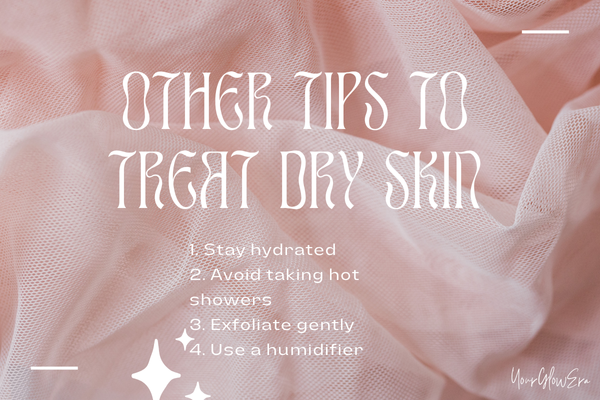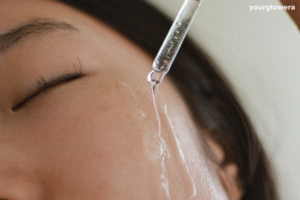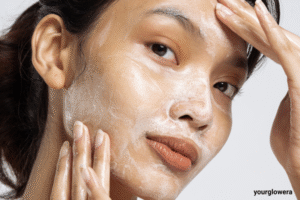Dry skin can be tricky to manage, especially in the morning when your skin feels tight and dehydrated after a long night.
A proper morning skincare routine for dry skin is essential to restoring hydration, giving you that fresh, dewy glow that everyone craves.
In this guide, we’ll walk you through the best steps to achieve a hydrated, glowing complexion with affordable products, all while making sure you’re taking the best care of your skin.
Table of Contents
What Causes Dry Skin?
Before diving into the steps, it’s important to understand what causes dry skin. Dry skin occurs when your skin loses moisture or doesn’t produce enough oils to keep it hydrated, leading to a flaky, rough, or tight feeling.
It can result from various factors like cold weather, dehydration, using harsh skin products, or simply genetics. Knowing this will help you select the best products that focus on restoring moisture and nourishment to your skin.
Step 1: Hydrating Cleanser (Morning & Night)
Using a hydrating cleanser is essential as the first step in any morning skincare routine for dry skin.
When you wake up, your skin is usually still a little dry or may have leftover product from the night before. Choose a gentle, hydrating cleanser that won’t strip away essential oils from your skin.
Look for one that contains ingredients like glycerin, hyaluronic acid, or ceramides, which are known for their ability to draw moisture into the skin.
Tip: Avoid harsh, foaming cleansers that can leave your skin feeling tight and more dehydrated. Opt for creamy, hydrating formulas that cleanse without compromising your skin’s natural barrier.
Step 2: Toner (Morning & Night)
Next up in your morning skincare routine for dry skin is toner. While toners were once associated with drying out the skin, modern formulations are all about hydration.
A hydrating toner balances your skin’s pH level and prepares it to absorb the products that follow. Look for toners that contain ingredients like aloe vera, rose water, or chamomile extract, which are soothing and hydrating.
Tip: After cleansing, apply your toner with a cotton pad or by gently pressing it into your skin with your hands for an added dose of moisture.
Step 3: Hydrating Serum (Morning & Night)
Serums are a concentrated treatment step that penetrates deep into your skin. When choosing a serum for dry skin, look for ones packed with hyaluronic acid, Vitamin C, or peptides.
These ingredients help to retain moisture, stimulate collagen production, and brighten your complexion.
Tip: Apply your serum while your skin is still slightly damp from toner to lock in hydration and give your skin an added boost of moisture.
Step 4: Moisturizer (Morning & Night)
The heart of any skincare routine, the moisturizer is essential to locking in all the hydration your skin needs. For dry skin, you’ll want a thick, emollient moisturizer that creates a protective layer over your skin.
Look for products that contain rich oils like jojoba, avocado, or shea butter. These ingredients help seal in moisture while providing nourishment to your skin throughout the day.
Tip: If your skin feels extra dry, don’t be afraid to layer on more moisturizer or reapply throughout the day. Your skin will thank you!
Step 5: Facial Oil (Morning & Night)
Facial oils can truly transform dry skin and make a noticeable difference. They provide an extra boost of hydration, helping your skin retain moisture while also protecting it from environmental stressors.
Oils like argan oil, rosehip oil, or marula oil are excellent for dry skin as they deeply hydrate and nourish the skin without clogging pores.
Tip: If you’re concerned about your skin being too oily during the day, use your facial oil at night. If you want to wear it in the morning, mix a drop or two into your moisturizer for a more lightweight feel.
Step 6: Sunscreen (Morning)
Applying sunscreen is essential for any skincare routine, particularly for those with dry skin. UV rays can cause your skin to become even more dry and damage the skin’s protective barrier.
Choose a hydrating sunscreen with SPF 30 or higher that won’t leave your skin feeling tight or greasy.
Look for formulas that include hydrating ingredients like aloe vera, hyaluronic acid, or glycerin to keep your skin feeling moisturized throughout the day.
Tip: Remember to apply sunscreen on cloudy days too, as UV rays can still pass through clouds and harm your skin.

Step 7: Eye Cream (Morning & Night)
The skin around your eyes is delicate and often one of the first places to show signs of dehydration. A good eye cream formulated for dry skin can help minimize puffiness, dark circles, and fine lines.
Look for an eye cream with hydrating ingredients like hyaluronic acid, peptides, and vitamin E to nourish the skin and improve elasticity.
Tip: Gently tap the eye cream around the orbital bone with your ring finger, as this applies less pressure and prevents tugging on the skin.
Keep Your Skin Hydrated Throughout the Day
For dry skin, dehydration can cause excess oil production, especially in the T-zone. Keeping your skin hydrated throughout the day will help keep oil production under control.
Recommendation: Keep a facial mist with hydrating ingredients on hand to refresh your skin throughout the day. Look for mists with aloe vera or rose water for a cooling, hydrating effect.
How to Hydrate Dry Skin
On the flip side, your cheeks and other dry areas need extra hydration, especially with a morning skincare routine for dry skin. Look for products that provide moisture and help maintain the skin’s natural barrier without adding oil.
• Hydrating Mask: Once or twice a week, treat your skin to a hydrating sheet mask to replenish moisture.
• Oil-Free Moisturizer: Make sure your moisturizer is lightweight but packed with hydrating ingredients like glycerin or hyaluronic acid.
Pay Attention to Your Diet and Water Intake
Your diet and drinks can impact the overall health and appearance of your skin. A balanced diet and staying hydrated are crucial for maintaining clear and healthy skin.
Recommendation: Stay well-hydrated by drinking plenty of water, and maintain a diet high in antioxidants, omega-3 fatty acids, and vitamins to promote healthy, glowing skin.
Adjust Your Routine Based on the Season
Depending on the season, you may need to adjust your skincare routine to effectively protect and nourish your skin year-round. In winter, your skin may need more hydration, while in summer, you may need to focus on oil control.
Recommendation: Adjust your moisturizer and sunscreen according to the season to keep your skin balanced year-round.
Avoid Harsh Products
Harsh products can aggravate dry skin. It’s important to use gentle, non-irritating products that don’t strip your skin of its natural oils.
Recommendation: Avoid using harsh scrubs or alcohol-based products that can dry out your skin and trigger more oil production.

Take Your Skin Type Into Account When Choosing Makeup
When selecting makeup products for your dry skin, ensure they align with your morning skincare routine for dry skin by choosing oil-free foundations and products that won’t block your pores.
Recommendation: Choose foundations that are oil-free and non-comedogenic to ensure they don’t make your skin more oily or clog pores.
Regularly Reevaluate Your Skincare Routine
Your skin may change over time, so it’s important to reevaluate your skincare routine periodically. If your skin becomes more oily or dry, you may need to make adjustments.
Recommendation: Always listen to your skin and be willing to modify your routine when necessary.
Professional Treatments for Dry Skin
When to Seek Professional Help
If you feel like your skincare routine isn’t working as well as it should, it might be time to seek professional help.
Consulting a dermatologist can help analyze your skin and recommend the most suitable products or treatments tailored to your skin type and specific concerns for a effective morning skincare routine for dry skin.
Professional Peels and Facials
Chemical peels and facials can be highly beneficial for those with dry skin. They help exfoliate the skin, clear clogged pores, and target both oily and dry areas.
Consult with a professional to determine which treatments are right for you.
Regular Skin Checkups
Even if you have a solid at-home skincare routine, regular checkups with a dermatologist can help ensure that you’re on the right track.
They can provide advice on managing your skin’s condition and help you stay on top of any emerging skin issues.
The Importance of Consistency
Stick to Your Routine
One of the keys to achieving great skin is consistency. The best morning skincare routine for dry skin is one that you follow consistently, day and night.
Results may take time, but with regular use, you’ll begin to notice improvements in your skin’s appearance.
Avoid Switching Products Too Often
While it’s tempting to try every new product that hits the market, it’s essential to stick to your skincare routine long enough to see the effects.
Regularly switching skincare products can cause unpredictable skin reactions and potentially exacerbate existing problems. It’s important to be patient and allow your morning skincare routine for dry skin enough time to show results.
Listen to Your Skin
As you go through your skincare journey, it’s important to pay attention to how your skin feels and reacts. If something doesn’t work, don’t be afraid to make changes.
Your skin is unique, so what works for someone else may not necessarily be effective for you.
Bonus Step: Overnight Mask
For dry patches on your skin, incorporate hydrating masks into your routine. Ingredients like honey, aloe vera, or cucumber extract can soothe and replenish moisture in the dry zones of your face. A hydrating mask once a week can make a noticeable difference.
Enhance your skin’s hydration as part of your morning skincare routine for dry skin by incorporating an overnight hydrating mask into your routine once or twice a week.
These masks are designed to lock in moisture while you sleep, leaving you with plump, glowing skin by morning.
How to Use Masks in Your Routine
Begin by cleansing your face as part of your morning skincare routine for dry skin, then apply the mask to the areas that need it.
If you’re using a clay mask for the oily T-zone and a hydrating mask for your cheeks, apply the clay mask first, rinse it off, and follow up with the hydrating mask.
Tip: Apply the mask as the last step in your evening skincare routine before going to bed. Wake up to deeply hydrated skin!
DIY Skincare Remedies for Dry Skin
1. Honey and Lemon Face Mask
Honey has moisturizing properties, while lemon acts as a natural astringent. A mask of both can help balance your skin’s hydration levels.
2. Oatmeal and Yogurt Mask
Mixing oatmeal and yogurt creates a soothing mask that calms dry skin while removing excess oils from the T-zone.
3. Cucumber Slices for Pore Control
Placing cucumber slices directly on the T-zone can help decrease oiliness and calm inflammation.

Other Tips to Treat Dry Skin
Besides following the basic skincare steps, here are some extra tips to keep your skin healthy and hydrated:
1. Stay hydrated: Drinking plenty of water is essential for maintaining your skin’s moisture levels. Make it a point to drink at least eight glasses of water each day to keep yourself properly hydrated.
2. Avoid taking hot showers: As hot water can strip your skin of its natural oils and lead to dryness. Opt for lukewarm water when washing your face and body.
3. Exfoliate gently: Exfoliation can help remove dead skin cells, allowing your moisturizers to penetrate better. Use a gentle exfoliator once or twice a week, and avoid abrasive scrubs that can irritate dry skin.
4. Use a humidifier: If you live in a dry climate or your home is heated in the winter, a humidifier can help add moisture to the air, preventing your skin from becoming even drier.

Conclusion
A proper morning skincare routine for dry skin doesn’t have to be complicated.
By following these simple steps and using the right products, you can nourish, hydrate, and protect your skin, leaving it glowing and refreshed all day long with a proper morning skincare routine for dry skin.
Don’t forget to drink plenty of water, avoid harsh skincare products, and invest in hydrating formulas that replenish and restore moisture.
Whether you’re on a budget or looking for luxury skincare, there are products that cater to your dry skin needs at every price point.
Are you tired of waking up to dull, dry skin every morning? Say goodbye to dryness with our comprehensive guide: “Say Goodbye to Dryness: A Morning Skincare Routine For Dry Skin.”
This routine is specially designed to nourish and hydrate your skin, leaving it feeling soft, plump, and radiant throughout the day.
Don’t miss out—read on to discover expert tips and effective methods to transform your mornings and wake up to beautifully moisturized skin every day!
Frequently Asked Questions
Which acid is best for dry skin?
A: Hyaluronic acid and lactic acid (in low concentrations) are generally well-tolerated by dry skin, making them ideal ingredients for your morning skincare routine for dry skin.
Is rice water good for dry skin?
A: Yes, it can help soothe and hydrate, but should be used in conjunction with a moisturizer.
How to fix dry skin on the face?
A: Cleanse with a gentle cleanser, layer hydrating products, use a rich moisturizer, and protect your skin from harsh elements as part of your morning skincare routine for dry skin.
Which facewash is best for dry skin for your morning skincare routine for dry skin?
A: Cream-based, non-foaming cleansers are best for dry skin in your morning skincare routine for dry skin.
Is toner good for dry skin?
A: A hydrating toner can help replenish moisture after cleansing as part of your morning skincare routine for dry skin.
Is Vaseline or coconut oil better for dry skin?
A: Vaseline (petroleum jelly) is generally better at locking in moisture and preventing water loss.
Can I apply coconut oil on my face overnight daily?
A: Coconut oil is occlusive, so it can trap moisture. However, not everyone tolerates it well. Patch-test and monitor your skin’s response.
What is the best oil for dry skin?
A: Oils like rosehip, argan, and squalane are often well-suited for dry skin, making them essential ingredients in a morning skincare routine for dry skin.
What is the disadvantage of coconut oil on skin?
A: It may clog pores in some individuals, leading to breakouts.
How long to leave coconut oil on dry skin?
A: It’s generally safe to leave overnight, but always assess your skin’s reaction.









Leave a reply